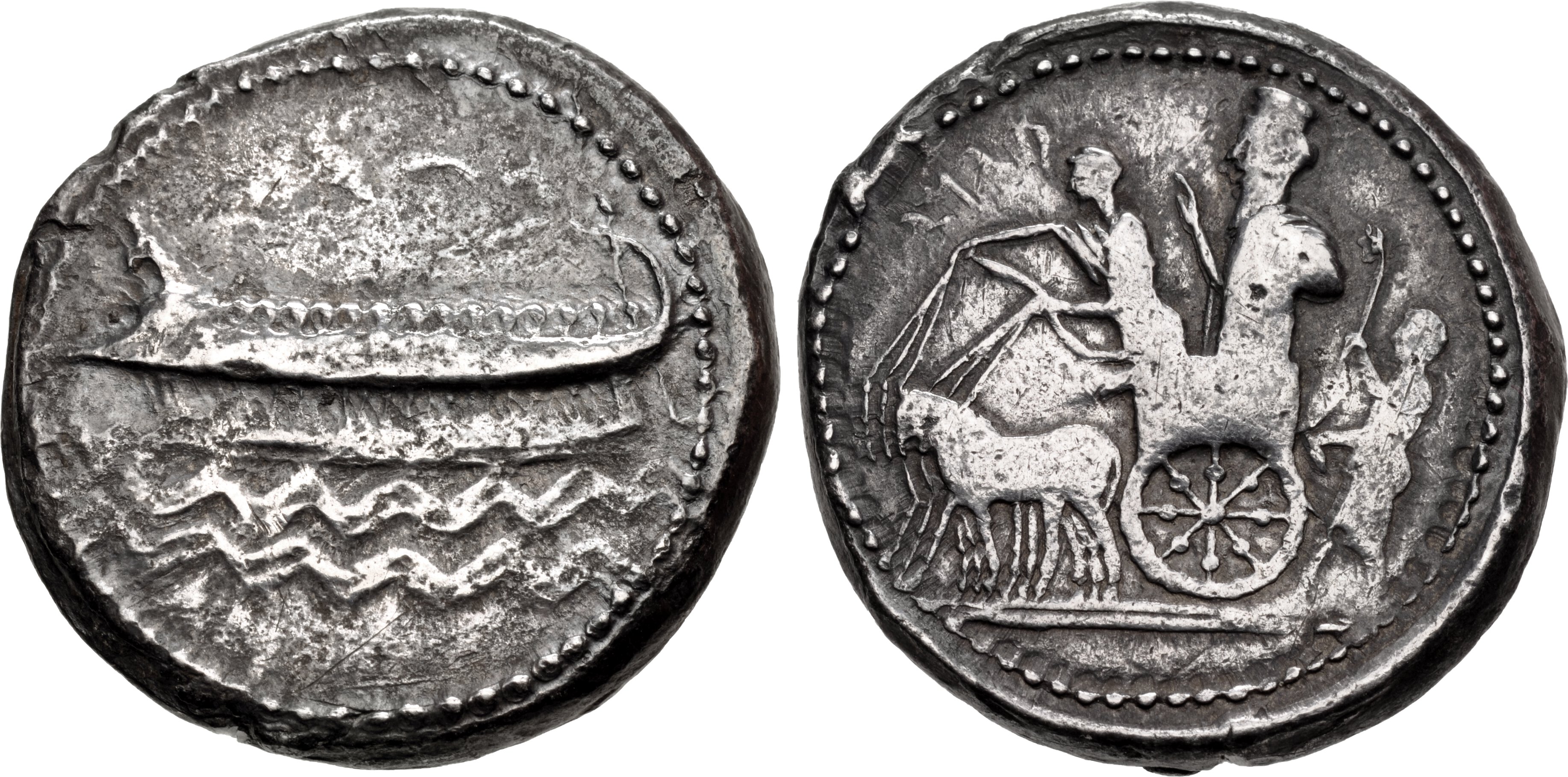Sidon (Mazday), silver, double shekels (353-333 BCE)
From SILVER
353 BCE - 333 BCE Silver 25,185 kg
Description
| ObverseInscription or printing placed on the obverse.: | Phoenician galley left, B, 10 (date), and traces of letters (all in Phoenician) above, waves below |
| ReverseInscription or printing placed on the reverse.: | MZDY above (Phoenician).King of Persia and driver in chariot drawn by three horses left, behind, King of Sidon standing left, in Egyptian dress, holding cultic scepter and votive vase |
Mint and issuing power
| MintIdentifies the place of manufacture or issue of a numismatic object.: | Sidon | Ancient regionAncient region.: | Phoenicia | Modern countryModern country: Lebanon | AuthorityIdentifies the issuing power. The authority can be "pretended" when the name or the portrait of X is on the coin but he/she was not the issuing power. It can also be "uncertain" when there is no mention of X on the coin but he/she was the issuing power according to the historical sources: | Mazday, Persian Empire |
Chronology
| FromIdentifies the initial date in a range assigned in a numismatic context. | 353 BCE | toIdentifies the final date in a range assigned in a numismatic context.. | 333 BCE | PeriodTime period of the numismatic object.: Classical 480-323 BC |
Physical description
| MetalThe physical material (usually metal) from which an object is made.: | Silver |
Median weightMedian of the weights of numismatic objects (in grams). in grams | 25.60 | DenominationTerm indicating the value of a numismatic object. Examples: tetradrachm, chalkous, denarius.: | double shekel | StandardStandard.: | Phoenician |
Image

S2003 Sidon Mazday double shekels.jpg [1]
References
| Die study referencePublication of the study: | Elayi - Elayi 20041Elayi - Elayi 2004, p. 291-311, n° 1924-2021 (Group IV.6.1) | ||
| Coin series referenceReference to coin series study: | Sear II2Sear II, n° 5946-5947, HGC 103HGC 10, n° 264 | ||
| Coin series web referenceCoin series web references: | |||
Obverse dies distribution
| FrequencyFrequency of specimen in distribution. ᵖ | Number of obversesNumber of obverse dies. ᵖ (o) | % (o) | Number of coinsNumber of coins. (n) | % (n) | Die nameName(s) of the die(s). |
| 1 | 14 | 42.42 | 14 | 18.92 | 2, 7, 14, 18, 19, 20, 22, 23, 25, 26, 28, 29, 31, 33 |
| 2 | 7 | 21.21 | 14 | 18.92 | 3, 9, 10, 11, 12, 15, 30 |
| 3 | 5 | 15.15 | 15 | 20.27 | 1, 13, 17, 21, 32 |
| 4 | 5 | 15.15 | 20 | 27.03 | 4, 6, 16, 24, 27 |
| 5 | 1 | 3.03 | 5 | 6.76 | 5 |
| 6 | 1 | 3.03 | 6 | 8.11 | 8 |
| Total | 33 of 33 | 99.99 | 74 of 74 | 100.01 |
Reverse dies distribution
no distribution is available
Quantification
| Number of obversesNumber of obverse dies. ᵖ (o) | 33 | Number of singletons (o1)The number of singleton coins. ᵖ | 14 |
| Number of reverse diesNumber of reverse dies. (r) | 44 | Number of coinsNumber of coins. (n) | 74 |
| Coins per obverse dieNumber of coins per obverse die. (n/o) | 2.24 | Coins per reverse dieNumber of coins per reverse die. (n/r) | 1.68 |
| Reverse per obverse ratioRatio of obverse dies divided by reverse dies. (r/o) | 1.33 | Percentage of singletons (o1)number of coins (n) divided by the number of singletons (o1) ᵖ | 42.42 % |
| Original number of dies (O) (Carter 1983 formula)The estimation of the number of coins according to Carter 1983 ᵖ | 49.19 | Coins struck if 20,000 as average productivity per dieCoins made if the average productivity for obverses (according to Carter) is 20,000. ᵖ | 983,800 |
| Original number of dies (O) (Esty 2011 formula)The estimation of the number of coins according to the singleton formula in Esty 2011 ᵖ (O) | 59.56 | Survival rate if 20,000 as average productivity per dieSurvival rate if average productivity is 20,000. ᵖ | 0.00008 |
| Coverage (o = % of O) (Esty 1984 formula)Esty 1984 - coverage (% of O) ᵖ (o = % of O) | 81.08% | Die productivity if survival rate 1/2,000Average productivity if survival rate is 1/2,000. ᵖ | 3,008.74 |
| Weight of silver (in kg) if 20,000 coins per die (O = Carter formula)Carter 1983 * Median weight * 20000 (*10 if gold or electrum) ᵖ | 25,185 kg <br /> 25,185 kg | Die productivity if survival rate 1/5,000Average productivity if survival rate is 1/5,000. ᵖ | 7,521.85 |
Remarks
Most likely one single workstation